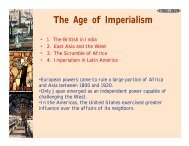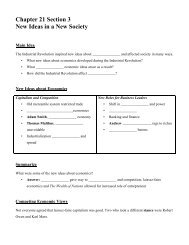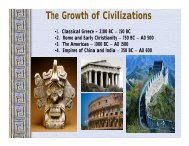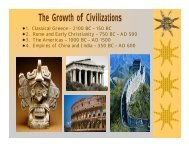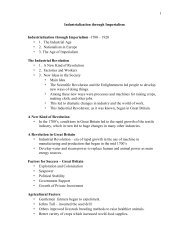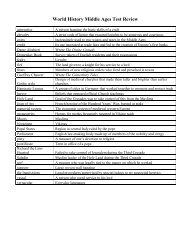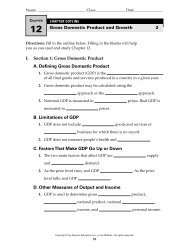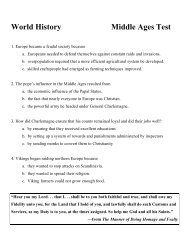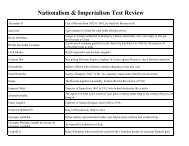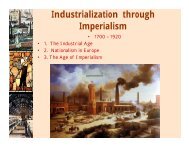The Industrial Revolution
The Industrial Revolution
The Industrial Revolution
Create successful ePaper yourself
Turn your PDF publications into a flip-book with our unique Google optimized e-Paper software.
<strong>Industrial</strong>ization through<br />
Imperialism<br />
• 1700 – 1920<br />
• 1. <strong>The</strong> <strong>Industrial</strong> Age<br />
• 2. Nationalism in Europe<br />
• 3. <strong>The</strong> Age of Imperialism
1700 -1920<br />
<strong>The</strong> <strong>Industrial</strong> <strong>Revolution</strong><br />
• 1. A New Kind of <strong>Revolution</strong><br />
• 2. Factories and Workers<br />
• 3. New Ideas in the Society<br />
•<strong>The</strong> Scientific <strong>Revolution</strong> and the Enlightenment<br />
led people to develop new ways of doing things.<br />
•Among these new ways were processes and<br />
machines for raising crops, making cloth, and other<br />
jobs.<br />
•This led to dramatic changes in industry and the<br />
world of work.<br />
•This <strong>Industrial</strong> <strong>Revolution</strong>, as it was known, began<br />
in Great Britain.
1. A New Kind of <strong>Revolution</strong><br />
1700 -1920<br />
• In the 1700’s, conditions in Great Britain led to the rapid<br />
growth of the textile industry, which in turn led to huge<br />
changes in many other industries.
A <strong>Revolution</strong> in Great Britain<br />
• <strong>Industrial</strong> <strong>Revolution</strong> – era of rapid growth in the use of<br />
machine in manufacturing and production that began in<br />
the mid 1700’s<br />
• Develop water and steam power to replace human and<br />
animal power as main energy sources.<br />
1700 -1920
Factors for Success – Great<br />
Britain<br />
• Exploration and Colonization<br />
• Sea power<br />
• Political Stability<br />
• Government Support<br />
• Growth of Private Investment<br />
1700 -1920
1700 -1920<br />
Agricultural Factors<br />
• Gentlemen farmers began to<br />
experiment.<br />
• Jethro Tull – invented the<br />
seed drill<br />
• Others improved livestock<br />
breeding methods to raise<br />
healthier animals.<br />
• Better variety of crops which<br />
increased world food supplies.<br />
• Enclosure movement – allowed<br />
for more efficient farming<br />
methods and increased food<br />
supply – large fenced in farms
1700 -1920<br />
Britain’s Big Advantage<br />
• Great Britain had all the essential elements that a nation<br />
needed to achieve economic success.<br />
• Factors of Production – land, labor, and capital<br />
That Nation of Shopkeepers! -- Napoleon Bonaparte
A <strong>Revolution</strong> in Textiles<br />
• Cottage industry – a craft occupation performed in the home<br />
• Weaving – cottage industry – began the <strong>Industrial</strong> <strong>Revolution</strong><br />
(cloth making or textiles)<br />
• <strong>Industrial</strong>ization – process of changing to power driven<br />
machinery<br />
1700 -1920
A New Way of Cloth<br />
1700 -1920<br />
• A influx of cotton from the Americas due to the slave labor in<br />
the southern states.<br />
• As Great Britain needed more cotton, slavery became even<br />
more entrenched (economic reason that led to civil war)<br />
• Eli Whitney – Cotton Gin<br />
• Richard Arkwright – Spinning Frame – used to spin stronger,<br />
thinner thread<br />
• New Machines were far to big to remain in cottages and it led<br />
to factories – a building that housed industrial machines
Steam Power for <strong>Revolution</strong><br />
1700 -1920<br />
• Physics – when water is heated and changed into steam,<br />
it expands.<br />
• Use steam to harness power to drive machines – changed<br />
the world
<strong>The</strong> Steam Engine<br />
1700 -1920<br />
• England – 1712 – James Watt –first steam engine to drive<br />
machinery<br />
• Led to a power source for ships –Robert Fulton – the first<br />
steam engine ship – Clermont<br />
• Used on the Hudson River – Albany to NYC
Coal for British Steam Engines<br />
1700 -1920<br />
• Early steam was<br />
fueled by burning<br />
wood from<br />
England’s forest<br />
• New fuel – coal –<br />
the increase in<br />
factories built to<br />
run on steam led to<br />
a coal mining<br />
industry in England<br />
– produced 80% of<br />
Europe’s coal
1700 -1920<br />
<strong>Industrial</strong>ism Spreads<br />
• <strong>Industrial</strong>ization increased rapidly and spread to<br />
western Europe and the United States.<br />
• Asia and Africa – industrialized in 1800’s during age of<br />
imperialism<br />
• Individual freedom on economic activity led to<br />
increased industrialization in western Europe.
Industry Comes to America<br />
1700 -1920<br />
• <strong>The</strong> United States, because of its economic relationship with<br />
Great Britain, was one of the first to benefit from England’s<br />
industrialization.<br />
• Alexander Hamilton – Secretary of Treasury under George<br />
Washington – argued that industrialization would help the<br />
United States.<br />
• Samuel Slater, a highly skilled mill worker from Great Britain,<br />
traveled to the United States to make a fortune.<br />
• Textile mill industry spread throughout northeast United<br />
States – Lowell mills
Industry Spreads to Europe<br />
• William Cockerill, an engineer from Great Britain brought<br />
industry to continental Europe.<br />
1700 -1920<br />
• Went to Belgium, which was the second industrialized nation to<br />
develop in Europe.<br />
• Delayed in France (French <strong>Revolution</strong> and Napoleonic Wars) and<br />
in Germany (no central government)
1700 -1920<br />
Industry in Asia<br />
• Eventually industrialization spread to Asia.<br />
• Came to Japan fairly late, but today Japan is one of the<br />
world’s industrial leaders.
1700 -1920<br />
2. Factories and Workers<br />
• <strong>The</strong> transition from cottage industries changed how<br />
people worked in factories and labor conditions in the<br />
factories.
Production before Factories<br />
1700 -1920<br />
• Production began with the cottages and increased due to<br />
the factories.
1700 -1920<br />
Cottage Industries<br />
• Benefits – controlled work schedule, product quality<br />
guaranteed, made own decisions, and created own work season.<br />
• Disadvantages – fire or floods in your home caused from<br />
machines, homes are too small,<br />
• As a result moves towards factories, which in turn led to<br />
factory towns
Factories and Factory Towns<br />
• A factory laborer had to leave his or her home and work in place<br />
built especially for an industry.<br />
• Meant support for the family, but caused real hardship.<br />
• Working in the Factory –<br />
• Divided into several separate, easily learned tasks<br />
• Children worked in the factories to help with expenses<br />
• Working conditions were very poor - lack of ventilation, poor<br />
sanitation<br />
• Long hours, little pay<br />
• Public recognized need to improve working conditions<br />
1700 -1920
1700 -1920<br />
Life in Factory Towns<br />
• Factories changed not<br />
only the lives of the<br />
workers, but also towns<br />
where they were located.<br />
• Early towns centered<br />
around rivers to harness<br />
power for the steam<br />
engines; also centered<br />
around coal mines<br />
• This in turn led to<br />
unsanitary living<br />
conditions in the towns –<br />
overpopulated and<br />
pollution – which led to a<br />
need to improve cities<br />
Age of<br />
Worker<br />
Male<br />
Wages<br />
Female<br />
Wages<br />
under 11 2s 3d. 2s. 4d.<br />
11 - 16 4s. 1d. 4s. 3d.<br />
17 - 21 10s. 2d. 7s. 3d.<br />
22 - 26 17s. 2d. 8s. 5d.<br />
27 - 31 20s. 4d. 8s. 7d.<br />
32 - 36 22s. 8d. 8s. 9d.<br />
37 - 41 21s. 7d. 9s. 8d.<br />
42 - 46 20s. 3d. 9s. 3d.<br />
47 - 51 16s. 7d. 8s. 10d.<br />
52 - 56 16s. 4d. 8s. 4d.<br />
57 - 61 13s. 6d. 6s. 4d.
1700 -1920<br />
<strong>The</strong> Factory System and<br />
Workers<br />
• Factories changed transformed the nature of labor.<br />
• Factories required large amounts of capital – money to<br />
pay for building the buildings<br />
• Led to wealthy people investing in business or industries<br />
to make profits.
Cottage Workers’ Unrest<br />
1700 -1920<br />
• Faced a particular challenge caused by the factory<br />
system.<br />
• Cottage workers could not compete with factories, and<br />
facing ruins, some of these workers turned to violence.<br />
• Luddites Movement – people who resisted using the day’s<br />
technologies because it put them out of work
Changing Working Conditions<br />
1700 -1920<br />
• <strong>The</strong> British government took a hands off approach to the<br />
workers unrest and did nothing to regulate business.<br />
• Because government took no action, this led to labor<br />
unions – organizations that represent workers’ interests<br />
• To urge employers to create better working conditions,<br />
less hours, higher pay, they turned to strikes – work<br />
stoppages<br />
• Parliament got involved and eventually banned unions and<br />
strikes, but did pass laws to protect worker’s interests.
A New Class of Workers<br />
1700 -1920<br />
• Factor work led to the growth of the middle class.<br />
• Managers and accountants kept the factories running<br />
and their books balanced. Engineers designed the<br />
machines and maintained them.
1700 -1920<br />
Factories and Mass Production<br />
• Factories changed the world of work and led to a massive<br />
increase in production.<br />
• Mass Production – system of manufacturing large numbers of<br />
identical items.<br />
• Interchangeable parts – identical machine made parts – mad e<br />
production and repair more efficient.<br />
• Assembly Line – Product moves from worker to worker, as each<br />
one performs a step in the manufacturing process.
Effects of Mass Production<br />
• Advantages – dramatic increase in production<br />
• Disadvantage – led to repetitious jobs<br />
• Factory work became the norm in manufacturing.<br />
1700 -1920
3. New Ideas in a New Society<br />
• <strong>The</strong> <strong>Industrial</strong> <strong>Revolution</strong> inspired new ideas about<br />
economic and affected society in many ways.<br />
1700 -1920
New Ideas about Economics<br />
1700 -1920<br />
• 1700’ and 1800’s - industrialization changed not only the<br />
way people lived, but also they way people thought about<br />
making money.<br />
• MERCANTILISM
1700 -1920<br />
New Roles for Business Leaders<br />
• Capitalism – thrives in England and led to theory that government<br />
should not interfere. Private ownwership<br />
• Laissez-faire – little government interference in a nation’s economy.<br />
• Adam Smith – <strong>The</strong> Wealth of Nations - markets free from government<br />
interference benefited all.<br />
• Thomas Malthus – population growth caused by the development of<br />
industry<br />
• Entrepreneur – someone who starts a new business<br />
– Andrew Carnegie – American steel industry<br />
– Cornelius Vanderbuilt – Railroad industry<br />
– John D. Rockefeller – Standard Oil
Competing Economic Views<br />
• Not everyone agreed that capitalism was the best<br />
economic system<br />
• Robert Owen – Socialism – government should own<br />
property, not the people (economic)<br />
1700 -1920<br />
• Karl Marx – more radical view – communism – government<br />
should own and control all factors of production<br />
(political)
1700 -1920<br />
Effects on Society<br />
• <strong>The</strong> rise of economic ideas was among the countless<br />
effects the industrial revolution had on society.<br />
• Shift to factory work transformed the everyday lives of<br />
men and women.<br />
• Men had to go to work in the factories, and women had<br />
to stay home and tend to the children. ‘Separate<br />
Spheres”
1700 -1920<br />
Effects on Countries<br />
• On a larger scale than home life, the industrial<br />
revolution also affected entire countries.<br />
• Europe –Great Britain, France, and Germany –leaders in<br />
the global market<br />
• <strong>The</strong> United States became an industrial super power.
1700 -1920<br />
Long-Term Effects on Societies<br />
• Increased standard of living – level of material comfort<br />
for people in industrialized nations.


